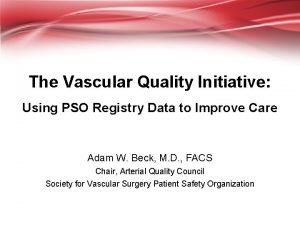PSO Overview for Executives Presenter Date Center for











- Slides: 11

PSO Overview for Executives (Presenter) (Date) Center for Patient Safety Toolkit for PSO Participation, Section 4

Patient Safety and Quality Improvement Act (PSQIA) • • PSQIA effective July, 2005 with final regulations published November, 2008 Key Provisions of PSQIA: – Allows formation of Patient Safety Organizations (PSOs), which are private or public entities that are federally listed by the Secretary of the US Department of Health and Human Services (HHS). Purpose of PSOs: • Undertake efforts to improve patient safety and quality of health care • Develop and implement processes for voluntary and confidential reporting of adverse events and for providing feedback to participants • Participate in a national network of patient safety databases • Work with providers to identify and analyze threats to patient safety and other quality of care problems – Provides confidentiality to entities and individuals who report to a PSO – Provides protection from discovery of work product in legal proceedings (with defined exceptions) Center for Patient Safety Toolkit for PSO Participation, Section 4

(Name of Your Organization’s PSO) • Our organizations’ Patient Safety Organization (PSO) is (Name of PSO) • (Background of PSO, including date of PSO certification) • To participate in the (Name of PSO) the following activities are recommended: – Sign a contract – Develop PSO policies to define patient safety evaluation system (PSES) and patient safety work product (PSWP) – Form and educate PSES Workgroup – Submit data to PSO Center for Patient Safety Toolkit for PSO Participation, Section 4

5 Reasons to Participate in a PSO 1. Share good work we are doing as transparency contributes to improved patient safety for all 2. Take advantage of safe haven of federal protection for safety work product – Protect patient safety discussions and analysis currently taking place between hospitals and other providers to address safety issues across the continuum of care – Future integration with providers who are members of Accountable Care Organizations 3. ACA provision effective January 1, 2015 requires all hospitals with 50 or more beds to have a patient safety evaluation system to receive reimbursement from the HIE plans Center for Patient Safety Toolkit for PSO Participation, Section 4

Patient Safety Evaluation System (PSES) • The mechanism by which information can be collected, maintained, analyzed and communicated • “The collection, management, or analysis of information for reporting to or by a PSO” • Exists whenever the provider engages in patient safety activities for the purpose of reporting to a PSO • Exists whenever the PSO engages in these activities for patient safety purposes Center for Patient Safety Toolkit for PSO Participation, Section 4

Patient Safety Evaluation System (PSES) Workgroup • PSES workgroup consists of the core individuals/committees who routinely perform patient safety and quality analysis and improvement work. • Other individuals with special subject matter expertise may be called upon as deemed necessary for work on specific events or issues. • All PSES workgroup members must sign a confidentiality agreement specific to PSWP. • Make-up of PSES Workgroup and responsibilities are defined in PSO policy. Center for Patient Safety Toolkit for PSO Participation, Section 4

Patient Safety Work Product (PSWP)? • Any data, reports, records, memoranda, analyses, or written or oral statements which could improve patient safety, quality improvements or health care outcomes, and which: – a provider assembles as part of its reporting to a PSO and which it does report, or – reflect the work of the PSES or the fact that information was reported to the PSES • PSWP is confidential and should not be disclosed by any member of the PSES Workgroup Center for Patient Safety Toolkit for PSO Participation, Section 4

Examples of PSWP to submit to PSO • Event, near miss and unsafe condition reports • Root Cause Analysis, Failure Mode and Effects Analysis, Learning from Defect Analysis or other proactive risk assessments • Notes from patient safety huddles or rounds, telephone calls or hallway conversations • Quality outcome reports such as blood utilization, complications or Core Measure variances • Minutes from committees/teams where patient safety/quality improvement is discussed, such as Quality, Safety, P&T, Infection Prevention, among others Center for Patient Safety Toolkit for PSO Participation, Section 4

Patient Safety Work Product • PSWP does not include: – patient medical records, billing and discharge information or any other original patient or provider information – Data and reports generated for submission to external agencies to meet mandatory or voluntary reporting requirements – Improvements, process and policy changes, and Action Plans made as a result of work within the PSES or the PSO • PSES Workgroup determines whether information developed in the PSES, or reported to it, becomes protected PSWP and what is reported to the PSO. Center for Patient Safety Toolkit for PSO Participation, Section 4

Putting It All together • Sign PSO contract with (Name of PSO) • Establish, define and document a Patient Safety Evaluation System (PSES) • Define Patient Safety Work Product (PSWP) that is collected and maintained in the PSES • Establish PSES Workgroup, who discusses, analyzes and manages the PSWP to determine: • What should be shared with workforce to improve patient safety and quality of care • What to submit to the PSO for broader learning • Each member of our PSES Workgroup agrees to maintain confidentiality of all PSWP. • Submit data and other information to the PSO. Center for Patient Safety Toolkit for PSO Participation, Section 4

Questions or Assistance (Enter Contact Information for Your Organization’s PSO Contact): (Enter Contact Information for Your PSO) Center for Patient Safety Toolkit for PSO Participation, Section 4





















